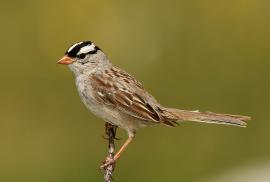Guide to Boreal Birds
Overview
The handsome White-crown is a favorite not only of bird-watchers but of laboratory scientists. Much of what we know about the physiology of bird migration has been learned from laboratory experiments with this species. The northern, northwestern, and mountain subspecies of White-crowned Sparrows have slightly different head patterns and songs. Song dialects vary locally as well. In the Arctic, where the sun does not set during the breeding season, these sparrows sing all night long; however, White-crowns farther south, in the Pacific Northwest, also sing frequently during the dark May nights. In the East, these birds are much less numerous than White-throated Sparrows, but flocks of White-throats often contain a few of these slender, elegant birds. Much of their feeding is done on the ground but, like White-throats, they will respond to a squeaking noise made by an observer by popping up to the top of a bush.
Habitats used by White-crowned Sparrow differ remarkably across its breeding range. Necessary habitat features of breeding territories include grass, bare ground for foraging dense shrubs or small conifers thick enough to provide a roost and conceal a nest, standing or running water, and sometimes tall coniferous trees. There are a number of different subspecies of White-crowned Sparrow that differ in their migratory patterns and timing. This species is remarkably adaptable in its food preferences, taking seeds and arthropods from the ground and plants, and hawking insects from perches. Breeding habitat throughout Canada appears to be abundant and populations stable.
Description
6-7 1/2" (15-19 cm). Similar to White-throated Sparrow, but more slender, without white throat, and generally with a more erect posture. Crown has bold black and white stripes. Upperparts streaked, underparts clear pearly gray. Pink bill. Young birds similar, but crown stripes buff and dark brown, underparts washed with dull buff.
Voice
Short series of clear whistles followed by buzzy notes.
Nesting
3-5 pale green eggs, thickly spotted with brown, in a bulky cup of bark strips, grass, and twigs, lined with grass and hair, on or near the ground.
Habitat
Nests in dense brush, especially near open grasslands; winters in open woods and gardens.
Range/Migration
Breeds from Alaska and Manitoba east to Labrador and Newfoundland, and south in western mountains to northern New Mexico and central California. Winters north to southern Alaska, Idaho, Kansas, Kentucky, and Maryland.



